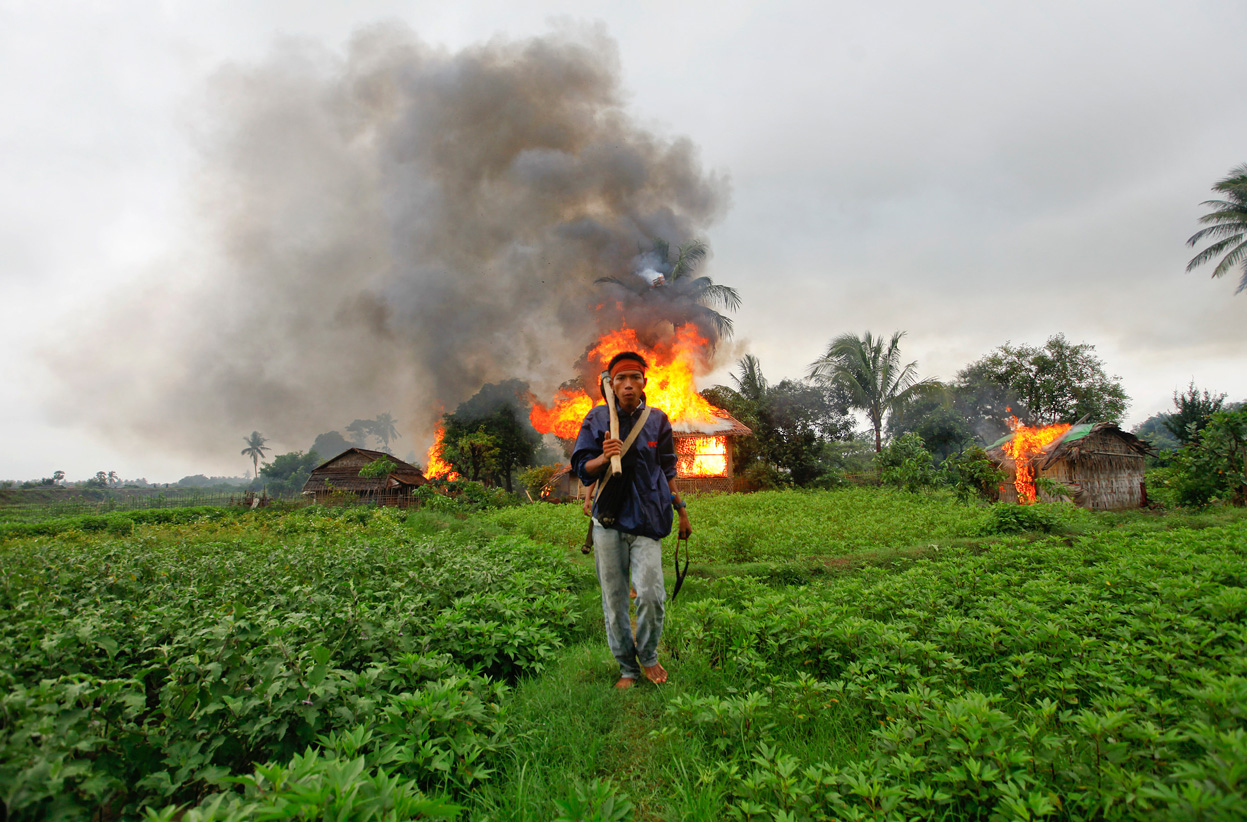August 27, 2013 – A failed attempt to initiate violence by 969 members, including Buddhist monks, illustrated something of the method of ethnic cleansing in Burma. A masked man in Thandwe attacked a Buddhist woman. While there was no way to determine the attacker’s ethnicity, organized Rakhine crowds operated under the assumption, or ruse, that the man was Muslim.

Here was a clear attempt by ultra-nationalist organization 969, a group officially backed by Thein Sein and the Burmese government, to stage a crime in order to initiate ethnic cleansing in Thandwe using the same formula successfully employed in other Burmese locales including Thandwe itself earlier this year.
In Lashio, on May 29, 2013, a rumor that a Muslim man had set a Buddhist woman on fire was circulated. Crowds surrounded a local police station, demanding to lynch the suspect. When the police refused to hand over the suspect, the crowd conducted ethnic cleansing of the town, destroying Muslim shops, mosques, and homes with fire and rudimentary weapons. Some locals noted that the violent thugs seemed not to be local residents and witnesses noted the singing of patriotic Myanmar songs, something very unusual in Shan State which has been in conflict with the nationalist military government for decades. Security forces tolerated the violence for two days before restoring order.
In Thandwe, on July 1, 2013, a rumor that a Muslim man had sexually assaulted a Buddhist woman was circulated. A crowd of about 50 formed outside a local police station, demanding to lynch the suspect. When police refused, the crowd burned down two Muslim houses. While security forces were able to disperse the crowd, three Muslims were injured.
In Htan Kone, on August 25, 2013, a rumor that a Muslim man had sexually assaulted a Buddhist woman was circulated. Crowds surrounded a local police station, again demanding to lynch the suspect. Police refused and the crowd conducted a campaign of ethnic cleansing, destroying Muslim homes and property. Security forces allowed the 1000-strong rioters to conduct their campaign before restoring order and conducting some 12 unconfirmed arrests. A Member of Parliament who later went to investigate the violence was refused access to the alleged 12 detainees and told by locals that many of the rioters were not from Htan Kone.
In Thandwe Township, on October 1, 2013, a conflict over parking escalated to attacks on Kaman Muslims as over 100 houses were razed by rampaging mobs in villages in Thandwe Township. Security Forces disarmed the Muslim villages in advance, then stood by and told Muslims to run away as the mobs killed Muslims and torched Kaman homes. Burmese President Thein Sein and several other observers commented that attackers appeared to be outsiders.
Something of a pattern is emerging with regard to ethnic cleansing in Burma. In all above examples, as well as ethnic cleansing conducted in Sittwe, Meiktila, and Okkan, the formula was followed more or less to the letter:
1) A crime, real or imagined, is rumored to have been committed against a Buddhist.
2) An organized mob is formed quickly outside a local police station, if the suspect is being held there.
3) The police, appearing to uphold the rule of law, refuse access to the suspect.
4) The mob conducts ethnic cleansing and killing in the area.
5) Security forces stand by and observe the violence without intervening.
6) The Muslim population moves into squalid, isolated ghettos or IDP camps, where they are persecuted by security forces.
7) After the event, some witnesses report that many of the rioters appeared not to be locals.
The second step in the process, while it is not always a feature of the violence, is essential to the foreign relations of Burma. The police are able to maintain the appearance of upholding the rule of law. When the mobs commit violence, however, security forces stand by and do nothing, or, in some cases as the BBC reported, have been observed to be actively involved in the violence. This latter feature has waned recently, with security forces restoring order in two to three days, after the bulk of ethnic cleansing has been achieved. The curious reports that many of the rioters appear not to be locals have brought into question whether groups of rioters are actually transported in by government or 969 organizers. Groups potentially involved could include the allusive Swan Arshin or Taung Tha Army, although no hard evidence exists to support this.
Security forces have also been involved in a controversial campaign to register Rohingya Muslims as “Bengali,” an attempt to back legal expulsion of the group from Burma or possibly a stage in the preparation for genocide. In July, the border security force Nasaka was disbanded, but almost immediately the same ex-Nasaka members were observed in instances of government violence in IDP camps, sources in Burma reported to the Sentinel Project as recently as late August.
